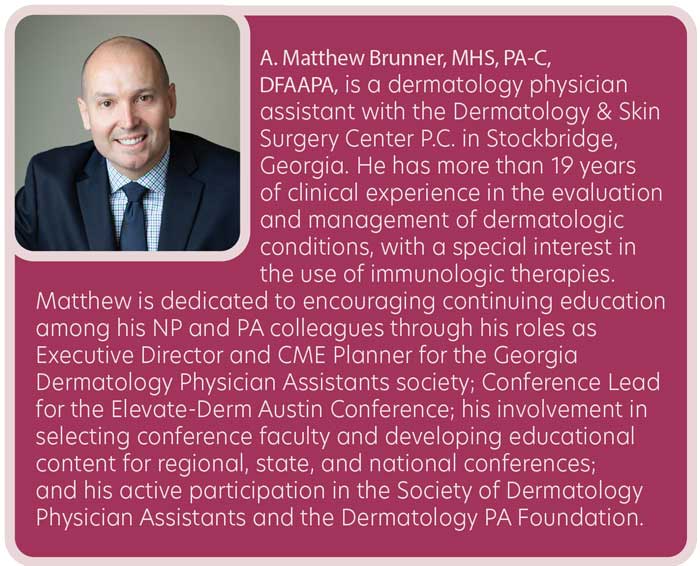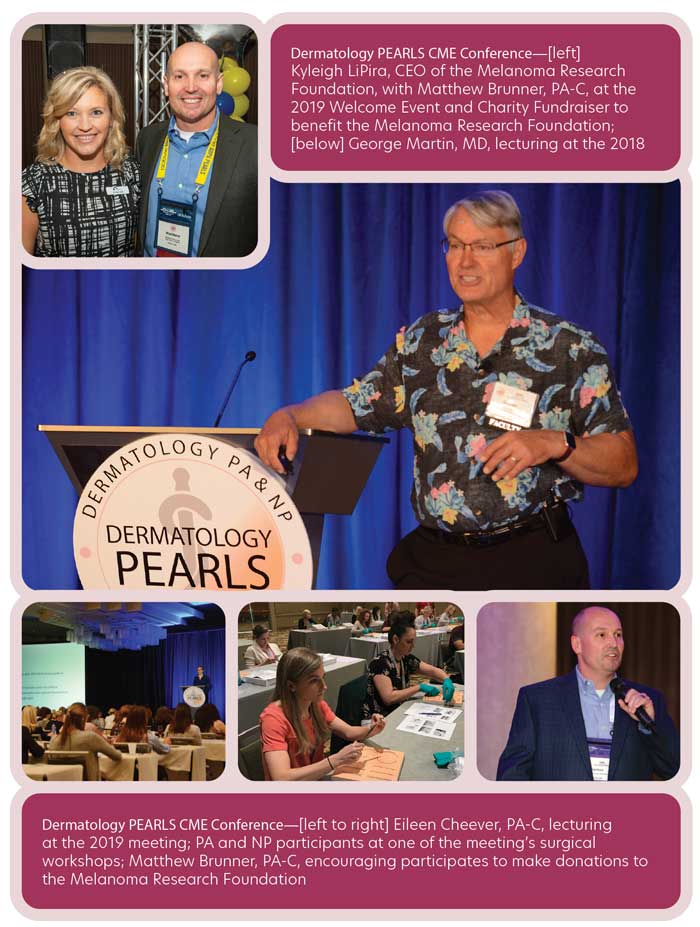
What led you to get involved in planning continuing medical education (CME) conferences?
Matthew: As a student of history, I feel the best way to answer this question is to look at these meetings and my career chronologically. In 2001, I was a brand new dermatology PA, excited to attend my first educational conference. However, due to the horrific occurrence of 9/11, the conference, scheduled to take place the following weekend in Santa Fe, was canceled. Though the meeting was canceled, the tragedy of 9/11 strengthened my desire to become immersed in the study of dermatology and become the best practitioner I could be.
A year later, I had the opportunity to attend another CME conference—I can still remember the passion and joy I felt listening to the lectures, learning from dermatology experts, and improving my diagnostic and therapeutic skills as a PA. A few years later, I helped the Georgia Dermatology Physician Assistants (GDPA) society establish its annual conference, eventually becoming the Conference Chair for the GDPA’s Dermatology PEARLS Conference. This year, the GDPA’s annual meeting will be celebrating its 12th anniversary, and it’s a real honor to continue to serve my colleagues in the role of Conference Chair.
A few years after I helped the GDPA society establish their annual meeting, I was elected Director at Large of the Society of Dermatology PAs (SDPA), and later, their President. Here, I assisted with the society’s CME conferences as a Board Advisor initially and then later as the CME Director of Conferences. It was an incredible opportunity to help shape and bring innovation to the SDPA conferences, elevating educational opportunities for NPs and PAs in dermatology. During this time, I met George Martin, MD, who invited me to serve as an Advisory Board Member for his MauiDerm NP+PA Conferences. I’m genuinely grateful for the knowledge and mentoring George has provided me over the years.
Are you seeing a rise in demand for CME conferences that specifically serve the dermatology NP and PA community?
Matthew: The year 2019 marked a fantastic growth in demand for high-quality CME conferences specifically designed for dermatology NPs and PAs. I think we can attribute this demand to the explosion of growth in our profession. The GDPA’s meeting now sells out each year, as does the Florida Society of Dermatology PAs’ New Wave Dermatology Conference. The SDPA’s Fall Conference in 2019 had over 700 registrants, and its registration was closed early.
Currently, the numbers in our profession have outgrown the capacities of existing educational conferences, which has created a need for quality continuing educational opportunities for NPs and PAs. Additionally, the difference in training models of NPs and PAs versus physicians dictates the needs of the NPs and PAs from an educational standpoint. Unlike our physician colleagues, who enter practice already having completed a dermatology residency, the majority of NPs and PAs enter the field with different training backgrounds, and this further underscores the need for educational conferences designed specifically for this group of healthcare professionals. Dermatology conferences that take our specific needs into account are the ones that are most attended by NPs and PAs.
With this educational need in mind, I am excited to announce the inaugural Elevate-Derm Conference, which will be held this November in the great city of Austin, Texas. The Advisory Board for this new meeting consists of six experienced dermatology PA and NP educators and clinicians, with me as Conference Lead. We specifically chose the city of Austin for the meeting’s location because of its welcoming downtown area and also because there is a lack of CME conference offerings in the state of Texas for the many dermatology NPs and PAs who practice there. The Elevate-Derm Conference Advisory Board Members and I are thrilled with the caliber of faculty and presentations we have lined up for the inaugural meeting this fall.

One of the goals of these CME conferences is to help NPs and PAs maintain their licensure and certification. The most important goal, though, is to assist NPs and PAs in expanding their medical knowledge and continually improving the care they provide their collective patient populations—this goal keeps me moving forward in the pursuit of excellence in education for my fellow PAs and NPs.
So, you strongly believe that NPs and PAs should remain committed to their continuing medical education.
Matthew: I do. All medical professionals, regardless of their terminal degree or credentials, have an obligation to their patients to remain committed to lifelong learning. The science of medicine is constantly evolving and continuously fluid, and we, as medical professionals, should be in the same pattern of continuous evolution. In the natural order of life, a malleable mind is needed to understand new concepts and adapt to change. Healthcare professionals must keep growing their minds through continuing education, so that they are able to synthesize the latest research into their clinical practice and adapt to innovations in medicine. What is old is still valuable, but only in light of what we know in the present.

Is it important for NPs and PAs to become involved in regional and state medical societies?
Matthew: Yes. Societies at the regional and state level are well suited to provide networking and community activities that bring together public citizens and dermatology providers. They also provide members with the opportunity to monitor for potentially harmful proposals from their state legislatures, encourage sentinel changes in legislation, and bring awareness and support to the local community through philanthropic activities and public service announcements. If you want to see change and improvement in your local and state communities, these societies are the place to make it happen.
What about participation in national societies?
Matthew: Participation in national societies can expand a practitioner’s professional circle beyond the local clinics and communities in which they practice. Medical society participation on a national level has allowed me personally to see the big picture of our specialty. It has provided me with a better understanding of the roles PAs and NPs play as dermatology professionals, as well as the impact they have on the field of dermatology. Opening dialogue between physician societies and PA and NP societies creates synergy, encourages positive action, and potentiates results.
What role should NPs and PAs play in patient education?
Matthew: Patient education has always been an area in which NPs and PAs excel. We have the opportunity to create meaningful dialogue with our patients to ensure each individual not only understands his or her diagnosis and treatment plan but is also equipped to integrate that knowledge into practical daily life. It’s not uncommon for patients to hop from dermatology clinic to dermatology clinic looking for the elusive cure to a chronic condition. It is incredibly rewarding to help a patient achieve that “a-ha” moment of understanding regarding the chronicity of his or her skin disorder. I’m probably more sensitive to this because of my own personal experience dealing with atopic dermatitis. It took visiting three separate clinics before I finally understood the intermittent relapsing nature of my skin disorder and that it was not going away. Accepting my diagnosis led me to incorporating good skin care into my daily routine to help reduce flares and exacerbations. As NPs and PAs, we have the opportunity to positively impact our patients in a similar way. We should never neglect an opportunity to have the right conversation with a patient about his or her skin condition and personal expectations of treatment.
How do you motivate patients to become engaged and stay engaged in their treatment?
Matthew: I think all medical professionals struggle at times with treatment nonadherence among their patients. Practitioners, such as Steven Feldman, MD, have famously spent good bits of their careers studying the rates of patient adherence to treatment; however, ultimately, trying to find the panacea to nonadherence remains elusive. I think part of the reason many patients find treatment adherence challenging is that their individual motivations and prerogatives are not being adequately addressed in their treatment plan. An excellent example of this is the acne patient who only cares about the getting rid of the post-inflammatory hyperpigmentation (PIHP), with no desire to treat the acne that’s causing the PIHP. I believe we need to get to know each patient on an individual basis to better understand his or her treatment needs, expectations, and psyche if we want to motivate our patients to remain engaged in their personal healthcare.
How are PAs and NPs most effectively utilized in a dermatology clinic?
Matthew: There are many valid models for a team-based practice of dermatology across this country. However, I think the most successful clinics are the ones in which each team member feels valued, acknowledged, and fairly compensated. It is difficult to feel ongoing professional fulfillment if your coworkers or employer do not treat you with respect and/or overwork or mistreat you emotionally or financially. It is a recipe for resentment and could lead to the loss of good team members, which is counterproductive to the continuity of care for the clinic’s patients.
What emerging therapies/technologies in dermatology are you most excited to see coming?
Matthew: We are seeing the expansion of effective therapeutics for previously recalcitrant conditions, such as psoriasis and uncontrolled atopic dermatitis. And new, more accessible, and more effective therapies for vitiligo and alopecia are emerging as well. It is very exciting to see new treatment options emerge that will help alleviate the suffering of our patients.
Is there a particular disease state in clinical dermatology about which you are particularly passionate?
Matthew: When I was in PA school, I was particularly drawn to the treatment of psoriasis, which led to my master’s research project on psoriasis vulgaris, a then nearly recalcitrant condition that was best treated by broad immunosuppressants (e.g., methotrexate, cyclosporine). This interest led me to pursue dermatology as a specialty and to a particular interest in targeted biologic therapies for treatment of psoriasis. Along the way, a close family member was diagnosed with psoriatic arthritis and, later, plaque psoriasis, and I was able to witness first-hand how these new targeted biologic therapies can transform patients’ lives. However, while we certainly have helped break down barriers to care and have improved the quality of life for many patients with psoriasis, to say that the heartbreak of psoriasis is over is a stretch, and we must continue striving for better, more effective treatments for this patient population.
What do you find most rewarding about being a PA in the field of dermatology?
Matthew: I have the honor of working in a specialty that is unlike any other in medicine. As dermatology practitioners, we are able to directly impact the quality of life of our patients, who entrust us to help them improve their appearance, symptoms, and emotional well-being. It’s a humbling privilege and honor to work in this specialty. I wouldn’t trade dermatology for any other field in medicine.
What advice do you have for new NPs and PAs who are considering the field of dermatology?
Matthew: I would remind NPs and PAs that, when they are seeking employment, they are interviewing the potential employers and their practices just as much as the potential employers are interviewing them. PAs and NPs should be just as selective regarding where they work as the clinics are who hire them. Don’t put yourself in a difficult situation. Seek out a physician who is looking to be a mentor and a teacher. Don’t let the wrong job become the “yes” job just to get a foot in the door. A practitioner’s patients and career will suffer from the wrong job fit. Before looking for the right job in dermatology, NPs and PAs should start their education in the specialty. Pick up a dermatology textbook and begin digesting the content and taking notes. Join a specialty organization and take advantage of the education and networking opportunities the organization offers. Once an NP or PA becomes established, he or she should always remember to give back. Become a member of state and national organizations, and when you have your feet under you, stand up and volunteer. Many have come before you, so help the ones who are beside you and those who will follow you. As one of my physician mentors likes to say, “The world is round—What you give out comes back to you!”

